buttons SKODA OCTAVIA 2009 2.G / (1Z) Amundsen Navigation System Manual
[x] Cancel search | Manufacturer: SKODA, Model Year: 2009, Model line: OCTAVIA, Model: SKODA OCTAVIA 2009 2.G / (1Z)Pages: 38, PDF Size: 2.52 MB
Page 6 of 38
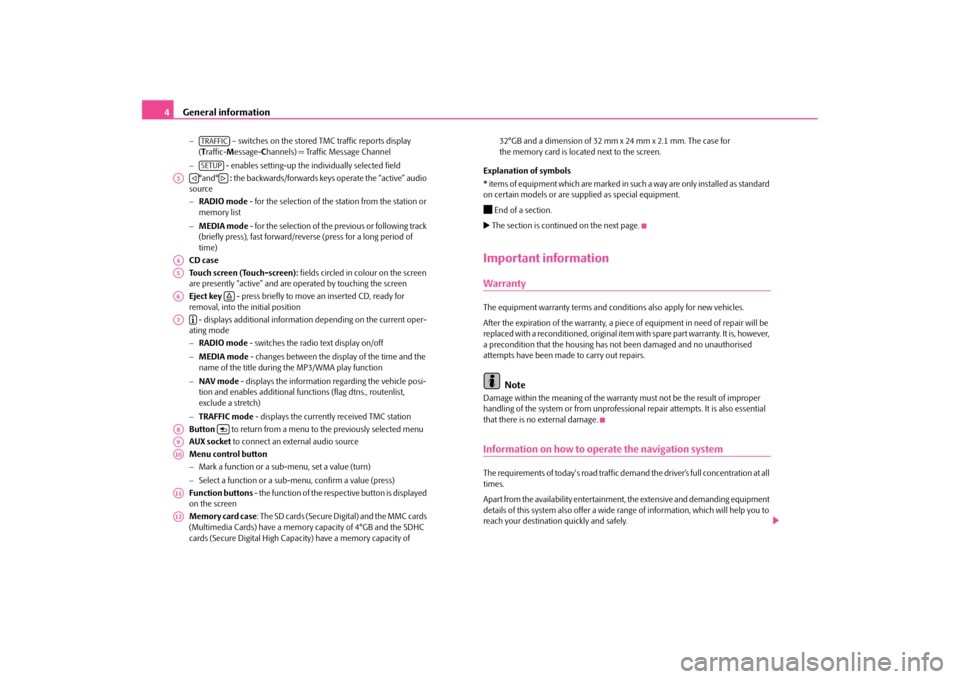
General information
4
−
– switches on the stored TMC traffic reports display
( Traffic-
Message-
Channels) = Traffic
Message Channel
−
- enables setting-up the individually selected field
°and°
: the backwards/forwards keys operate the “active” audio
source − RADIO mode
- for the selection of the station from the station or
memory list − MEDIA mode
- for the selection of the previous or following track
(briefly press), fast forward/reve
rse (press for a long period of
time) CD caseTouch screen (Touch-screen):
fields circled in colour on the screen
are presently “active” and are op
erated by touching the screen
Eject key
- press briefly to move an inserted CD, ready for
removal, into the initial position - displays additional informatio
n depending on the current oper-
ating mode − RADIO mode
- switches the radio text display on/off
− MEDIA mode
- changes between the display of the time and the
name of the title during the MP3/WMA play function − NAV mode
- displays the information regarding the vehicle posi-
tion and enables additional fu
nctions (flag dtns., routenlist,
exclude a stretch) − TRAFFIC mode
- displays the currently received TMC station
Button
to return from a menu to the previously selected menu
AUX socket
to connect an external audio source
Menu control button
− Mark a function or a su
b-menu, set a value (turn)
− Select a function or a sub-menu, confirm a value (press) Function buttons
- the function of the respective button is displayed
on the screen Memory card case
: The SD cards (Secure Digital) and the MMC cards
(Multimedia Cards) have a memory
capacity of 4°GB and the SDHC
cards (Secure Digital Hi
gh Capacity) have a memory capacity of
32°GB and a dimension of 32 mm x 24 mm x 2.1 mm. The case for the memory card is located next to the screen.
Explanation of symbols * items of equipment which are marked in such a way are only installed as standard on certain models or are supplied as special equipment.�ž End of a section.�b The section is continued on the next page.Important informationWarrantyThe equipment warranty terms and conditions also apply for new vehicles. After the expiration of the warranty, a piec
e of equipment in need of repair will be
replaced with a reconditioned, original item with spare part warranty. It is, however, a precondition that the housing has
not been damaged and no unauthorised
attempts have been made
to carry out repairs.
Note
Damage within the meaning of the warranty must not be the result of improper handling of the system or from unprofession
al repair attempts. It is also essential
that there is no external damage.Information on how to operate the navigation systemThe requirements of today's road traffic demand the driver’s full concentration at all times. Apart from the availability entertainmen
t, the extensive and demanding equipment
details of this system also offer a wide range of information, which will help you to reach your destination quickly and safely.
TRAFFICSETUP
A3
�ƒ
�„
A4A5A6
�š
A7
�º
A8
�y
A9A10A11A12s36c.b.book Page 4 Thursday, April 9, 2009 2:50 PM
Page 7 of 38
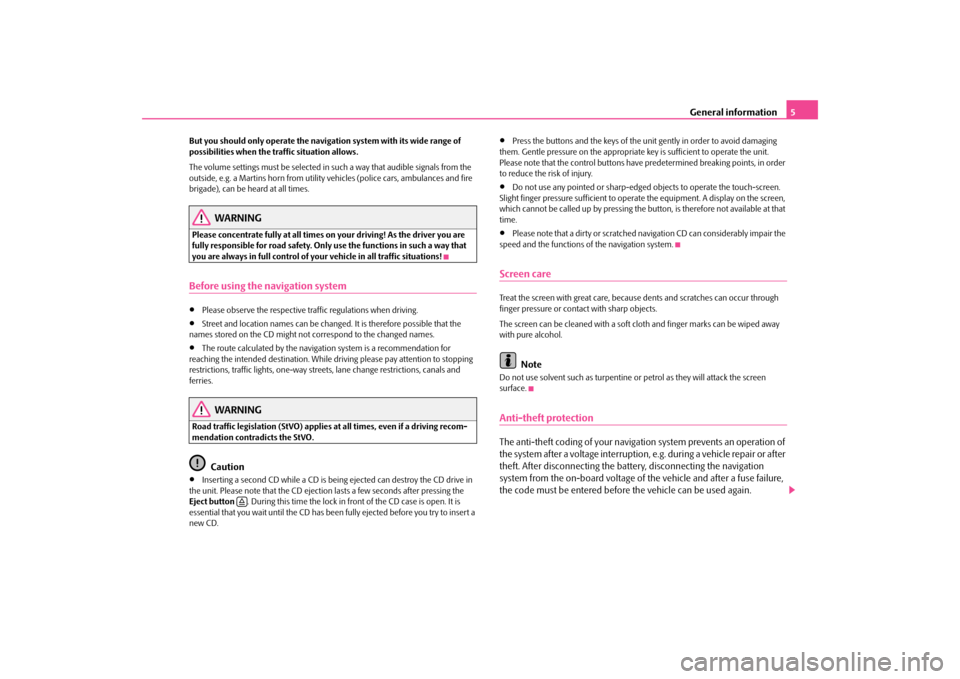
General information
5
But you should only operate the navigation system with its wide range of possibilities when the traffic situation allows. The volume settings must be selected in
such a way that audible signals from the
outside, e.g. a Martins horn from utility
vehicles (police cars, ambulances and fire
brigade), can be heard at all times.
WARNING
Please concentrate fully at
all times on your driving! As the driver you are
fully responsible for road safety. Only use the functions in such a way that you are always in full control of your vehicle in all traffic situations!Before using the navigation system•
Please observe the respective traffic regulations when driving.
•
Street and location names can be change
d. It is therefore possible that the
names stored on the CD might not correspond to the changed names.•
The route calculated by the navigation system is a recommendation for
reaching the intended destination. While
driving please pay a
ttention to stopping
restrictions, traffic lights, one-way streets, lane change restrictions, canals and ferries.
WARNING
Road traffic legislation (StVO) applies
at all times, even if a driving recom-
mendation contradicts the StVO.
Caution
•
Inserting a second CD while a CD is being ejected can destroy the CD drive in
the unit. Please note that the CD ejecti
on lasts a few seconds after pressing the
Eject button
. During this time the lock in fr
ont of the CD case is open. It is
essential that you wait until the CD has been
fully ejected before you try to insert a
new CD.
•
Press the buttons and the keys of the unit gently in order to avoid damaging
them. Gentle pressure on
the appropriate key is sufficient to operate the unit.
Please note that the contro
l buttons have predetermined
breaking points, in order
to reduce the risk of injury.•
Do not use any pointed or sharp-edged objects to operate the touch-screen.
Slight finger pressure sufficient to oper
ate the equipment. A display on the screen,
which cannot be called up by pressing the bu
tton, is therefore not available at that
time.•
Please note that a dirty or scratched na
vigation CD can considerably impair the
speed and the functions of the navigation system.Screen careTreat the screen with great care, becaus
e dents and scratches can occur through
finger pressure or contact with sharp objects. The screen can be cleaned with a soft cl
oth and finger marks can be wiped away
with pure alcohol.
Note
Do not use solvent such as turpentine or
petrol as they will attack the screen
surface.Anti-theft protectionThe anti-theft coding of
your navigation system prevents an operation of
the system after a voltage interruption,
e.g. during a vehicle repair or after
theft. After disconnecting the batt
ery, disconnecting the navigation
system from the on-board voltage of the vehicle and after a fuse failure, the code must be entered before the vehicle can be used again.
�š
s36c.b.book Page 5 Thursday, April 9, 2009 2:50 PM
Page 10 of 38
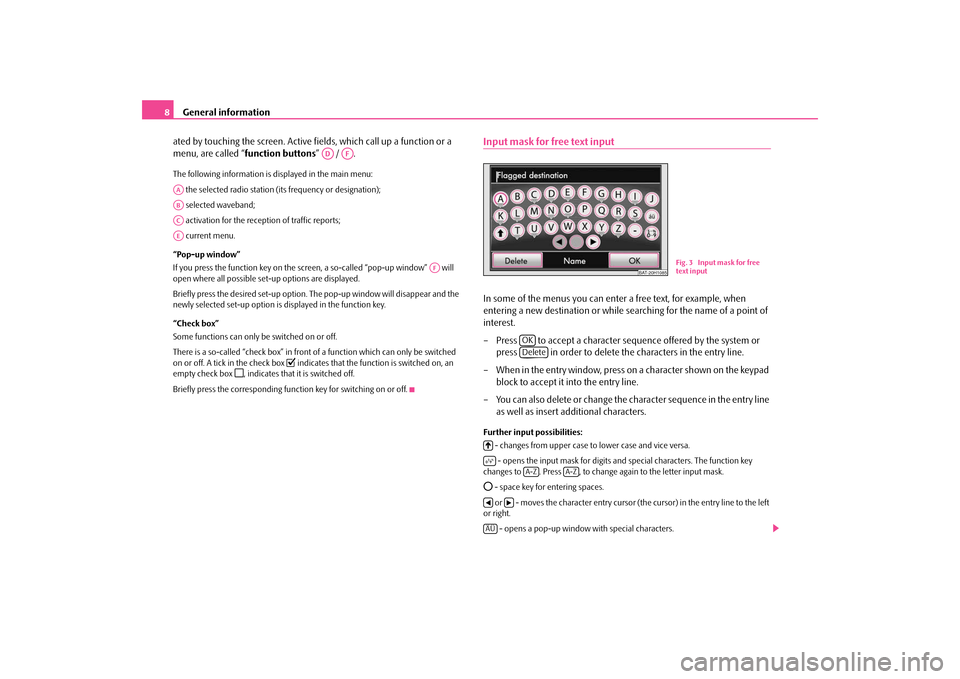
General information
8 ated by touching the screen. Active
fields, which call up a function or a
menu, are called “
function buttons
” / .
The following information is displayed in the main menu: the selected radio station (i
ts frequency or
designation);
selected waveband; activation for the rece
ption of traffic reports;
current menu. “Pop-up window” If you press the function key on the sc
reen, a so-called “pop-up window” will
open where all possible se
t-up options are displayed.
Briefly press the desired set-up option. Th
e pop-up window will disappear and the
newly selected set-up option is
displayed in the function key.
“Check box” Some functions can only
be switched on or off.
There is a so-called “check box” in front of a function which can only be switched on or off. A tick in the check box
�7 indicates that the functi
on is switched on, an
empty check box
�8, indicates that it
is switched off.
Briefly press the corresponding function key for switching on or off.
Input mask for free text inputIn some of the menus you can enter a free text, for example, when entering a new destination or while se
arching for the name of a point of
interest. – Press to accept a character se
quence offered by the system or
press in order to delete the characters in the entry line.
– When in the entry window, press on a character shown on the keypad
block to accept it into the entry line.
– You can also delete or change the character sequence in the entry line
as well as insert additional characters.
Further input possibilities: - changes from upper case to lower case and vice versa. - opens the input mask for digits an
d special characters. The function key
changes to . Press , to change again to the letter input mask.�˜ - space key for entering spaces. or - moves the character entry cursor (the cursor) in the entry line to the left or right.
- opens a pop-up window with special characters.
AD
AF
AAABACAE
AF
BAT-20H1085
Fig. 3 Input mask for free text input
OKDelete
�4�5
A-Z
A-Z
�‚
�b
ÄÜ
s36c.b.book Page 8 Thursday, April 9, 2009 2:50 PM
Page 20 of 38
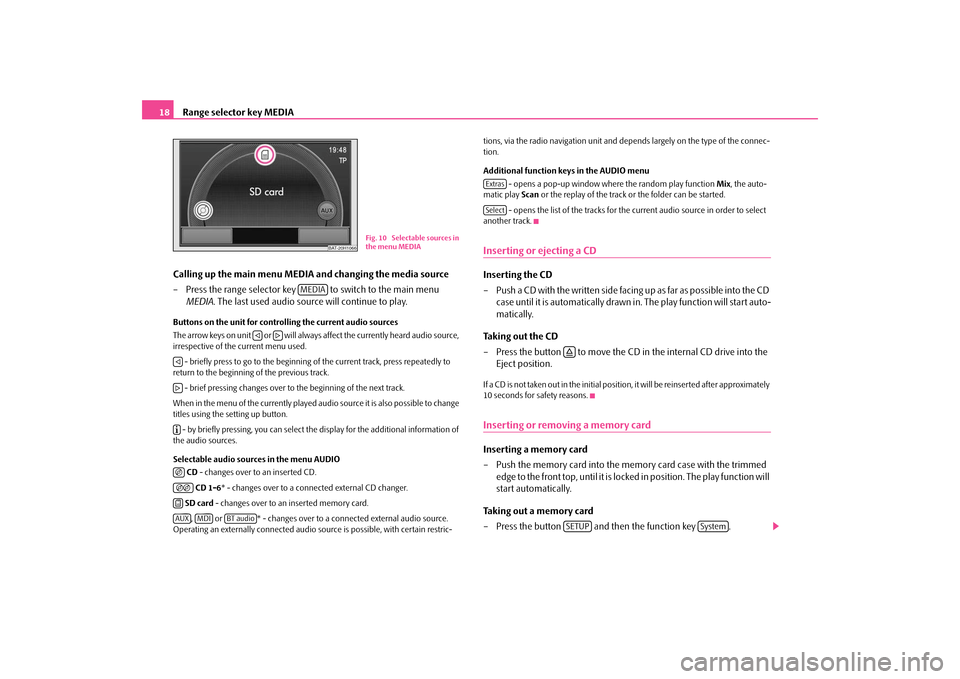
Range selector key MEDIA
18
Calling up the main menu MEDI
A and changing the media source
– Press the range selector key to switch to the main menu
MEDIA
. The last used audio source will continue to play.
Buttons on the unit for controlling the current audio sources The arrow keys on unit or will always affect the currently heard audio source, irrespective of the current menu used. - briefly press to go to the beginning of
the current track, press repeatedly to
return to the beginning of the previous track. - brief pressing changes over to the beginning of the next track.When in the menu of the currently played audio source it is also possible to change titles using the setting up button. - by briefly pressing, you can select the display for the additional information of the audio sources. Selectable audio sources in the menu AUDIO
CD - changes over to an inserted CD. CD 1-6
* - changes over to a connected external CD changer.
SD card
- changes over to an inserted memory card.
, or * - changes over to a connected external audio source.
Operating an externally connected audio
source is possible, wi
th certain restric-
tions, via the radio navigation unit and depends largely on the type of the connec- tion. Additional function keys in the AUDIO menu
- opens a pop-up window wher
e the random play function
Mix
, the auto-
matic play
Scan
or the replay of the track or the folder can be started.
- opens the list of the tracks for the current audio source in order to select
another track.Inserting or ejecting a CDInserting the CD – Push a CD with the written side facing
up as far as po ssible into the CD
case until it is automatically drawn in
. The play function will start auto-
matically.
Taking out the CD – Press the button to move the CD
in the internal CD drive into the
Eject position.
If a CD is not taken out in the initial position, it will be reinserted after approximately 10 seconds for safety reasons.Inserting or removing a memory cardInserting a memory card – Push the memory card into the me
mory card case with the trimmed
edge to the front top, until it is locked in position. The play function will start automatically.
Taking out a memory card – Press the button and then the function key .
BAT-20H1066
Fig. 10 Selectable sources in
the menu MEDIA
MEDIA
�ƒ
�„
�ƒ�„�º�F�F�F
�HAUX
MDI
BT audio
ExtrasSelect
�šSETUP
System
s36c.b.book Page 18 Thursday, April 9, 2009 2:50 PM
Page 21 of 38
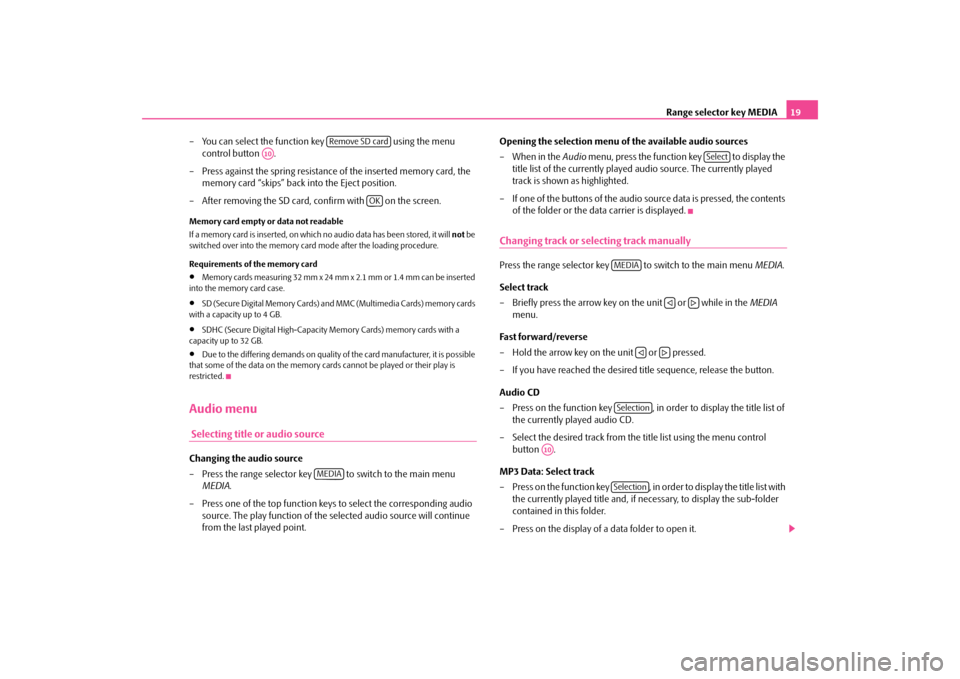
Range selector key MEDIA
19
– You can select the function key using the menu
control button .
– Press against the spring resistance of the inserted memory card, the
memory card “skips” back into the Eject position.
– After removing the SD card,
confirm with on the screen.
Memory card empty or data not readable If a memory card is inserted, on which no audio data has been stored, it will
not
be
switched over into the memory card mode after the loading procedure. Requirements of the memory card•
Memory cards measuring 32 mm x 24 mm x 2.1 mm or 1.4 mm can be inserted
into the memory card case.•
SD (Secure Digital Memory Cards) and MMC (Multimedia Cards) memory cards
with a capacity up to 4 GB.•
SDHC (Secure Digital High-Capacity Memory Cards) memory cards with a
capacity up to 32 GB.•
Due to the differing demands on quality of the card manufacturer, it is possible
that some of the data on the memory ca
rds cannot be played or their play is
restricted.Audio menu Selecting title or audio sourceChanging the audio source – Press the range selector key to switch to the main menu
MEDIA
.
– Press one of the top function keys to select the corresponding audio
source. The play function of the selected audio source will continue from the last played point.
Opening the selection menu of the available audio sources –When in the
Audio
menu, press the function key to display the
title list of the currently played audio source. The currently played track is shown as highlighted.
– If one of the buttons of the audio source data is pressed, the contents
of the folder or the data carrier is displayed.
Changing track or selecting track manuallyPress the range selector key to switch to the main menu
MEDIA
.
Select track – Briefly press the arrow key on the unit or while in the
MEDIA
menu.
Fast forward/reverse – Hold the arrow key on the unit or pressed. – If you have reached the desired title sequence, release the button. Audio CD – Press on the function key , in order to display the title list of
the currently played audio CD.
– Select the desired track from the title list using the menu control
button .
MP3 Data: Select track – Press on the function key , in order to display the title list with
the currently played title and, if ne
cessary, to display the sub-folder
contained in this folder.
– Press on the display of a data folder to open it.
Remove SD card
A10
OK
MEDIA
Select
MEDIA
�ƒ
�„
�ƒ
�„
Selection
A10
Selection
s36c.b.book Page 19 Thursday, April 9, 2009 2:50 PM
Page 27 of 38
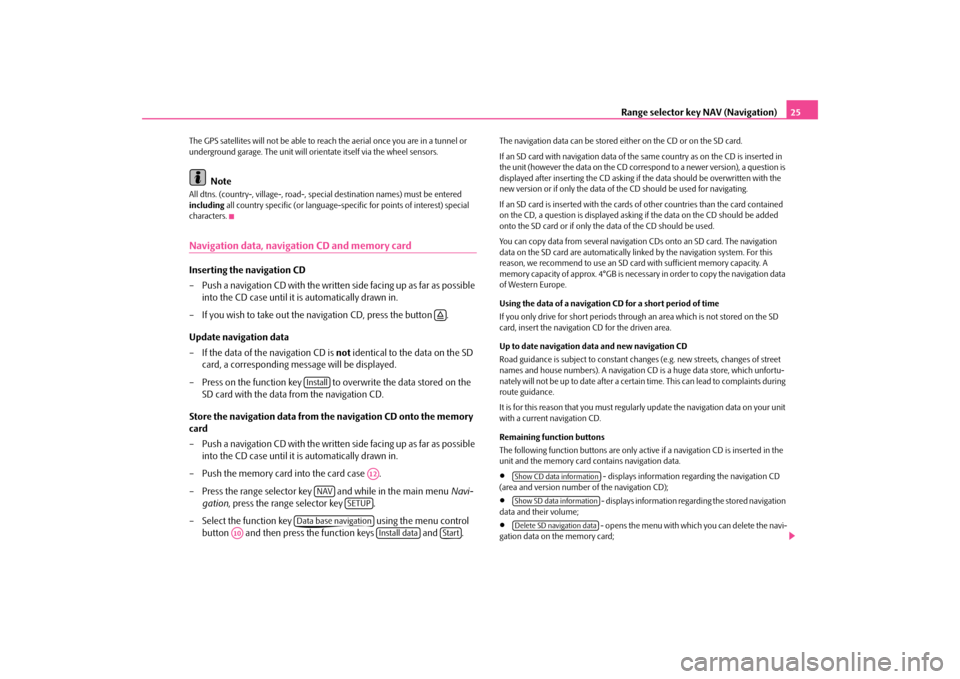
Range selector key NAV (Navigation)
25
The GPS satellites will not be able to reac
h the aerial once you are in a tunnel or
underground garage. The unit will orie
ntate itself via the wheel sensors.
Note
All dtns. (country-, village-, road-, spec
ial destination names) must be entered
including
all country specific (or language-spe
cific for points of interest) special
characters.Navigation data, navigation CD and memory cardInserting the navigation CD – Push a navigation CD with the written
side facing up as far as possible
into the CD case until it is automatically drawn in.
– If you wish to take out the navigation CD, press the button . Update navigation data – If the data of the navigation CD is
not
identical to the data on the SD
card, a corresponding message will be displayed.
– Press on the function key to overwrite the data stored on the
SD card with the data
from the navigation CD.
Store the navigation data from the navigation CD onto the memory card – Push a navigation CD with the written
side facing up as far as possible
into the CD case until it is automatically drawn in.
– Push the memory card into the card case . – Press the range selector key and while in the main menu
Navi-
gation
, press the range selector key .
– Select the function key using the menu control
button and then press the function keys and .
The navigation data can be stored ei
ther on the CD or on the SD card.
If an SD card with navigation data of the
same country as on the CD is inserted in
the unit (however the data on the CD correspond to a newer version), a question is displayed after inserting the CD asking if the data should be overwritten with the new version or if only the data of th
e CD should be used for navigating.
If an SD card is inserted with the cards
of other countries than the card contained
on the CD, a question is displayed asking
if the data on the CD should be added
onto the SD card or if only the
data of the CD should be used.
You can copy data from seve
ral navigation CDs onto an SD card. The navigation
data on the SD card are automatically li
nked by the navigation system. For this
reason, we recommend to use an SD card
with sufficient memory capacity. A
memory capacity of approx. 4°
GB is necessary in order to copy the navigation data
of Western Europe. Using the data of a navigation CD for a short period of time If you only drive for short
periods through an area which is not stored on the SD
card, insert the navigation CD for the driven area. Up to date navigation data and new navigation CD Road guidance is subject to
constant changes (e.g. new streets, changes of street
names and house numbers). A navigation CD
is a huge data store, which unfortu-
nately will not be up to date after a certai
n time. This can lead to complaints during
route guidance. It is for this reason that you must regula
rly update the navigation data on your unit
with a current navigation CD. Remaining function buttons The following function buttons are only active
if a navigation CD is inserted in the
unit and the memory card
contains navigation data.
•
- displays information regarding the navigation CD
(area and version number
of the navigation CD);
•
- displays information regarding the stored navigation
data and their volume;•
- opens the menu with which you can delete the navi-
gation data on the memory card;
�š
Install
A12
NAV
SETUP
Data base navigation
A10
Install data
Start
Show CD data informationShow SD data informationDelete SD navigation data
s36c.b.book Page 25 Thursday, April 9, 2009 2:50 PM